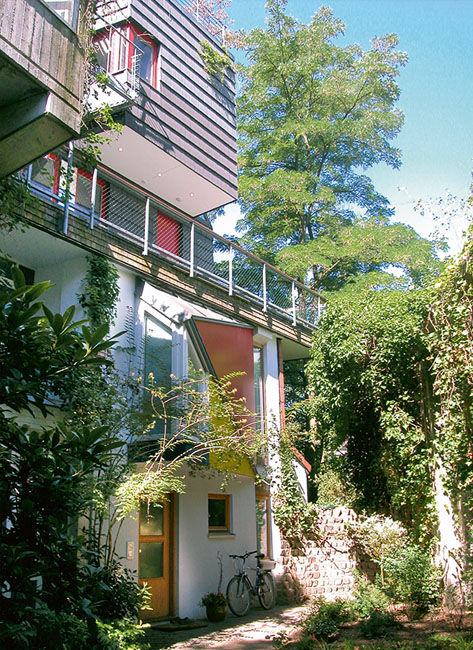Baumhäuser Berlijn
Frei Otto, Hermann Kendel, et al.
Samenvatting
Aan de rand van de Berlijnse Tiergarten, verstopt tussen sjieke ambassades en de postmoderne architectuur van de late jaren 1980 bevinden zich drie bonte clusters gestapelde zelfbouwhuizen. Ze zijn het resultaat van een intensief bouw- en planningsproces dat in 1981 begon, toen Josef Paul Kleihues verrassend genoeg Frei Otto (1925) uitnodigde om mee te doen aan de Berlijnse IBA van 1987. Verrassend, omdat Otto nauwelijks woningbouw in zijn portfolio had en omdat hij niet hoorde tot de postmoderne voorhoede van die tijd, die de Berlijnse IBA domineerde. Otto was vooral bekend om zijn fenomenale tentconstructies voor onder meer het Olympisch stadion in München uit 1972.
Het eerste voorstel betrof een locatie in Kreuzberg vlakbij de toenmalige muur en omvatte twee torens die op radicale wijze ruimte boden voor gestapelde zelfbouw van ongeveer 50 woningen binnen een betonnen draagstructuur met een kern van trappen, iets wat Otto al in 1959 had bedacht voor New York. Vanwege de opzet van een kern met vertakkende plateaus en een sterke relatie met de natuur door middel van hangende tuinen, noemde Otto dit concept een Baumhaus. Dit eerste ontwerp riep de nodige weerstand op en de Berlijnse Senaat verbande het experimentele project naar de kleinere, minder prominente kavel van de voormalige ambassade van het Vaticaan, waar pas in 1988 met de bouw kon worden begonnen. De bouwhoogte moest beperkt en de volumes moesten tussen de aanwezige bomen gepositioneerd worden, wat resulteerde in drie Baumhäuser van zes verdiepingen, die ogenschijnlijk vrij toevallig op hun plek zijn beland, waarvan uiteindelijk twee als collectieve zelfbouw zijn gerealiseerd.
De dragers van de zelfbouwhuizen bestaan uit overgedimensioneerde betonnen tafelconstructies die vrije ‘kavels’ bieden voor maisonnettes. Door middel van een collectief inspraakproces tussen de toekomstige eigenaar-bewoners (18) en hun eigen architecten (negen in totaal) werd de invulling bepaald. Dit sociale proces was onderdeel van de ecologische gedachte achter het project, maar bleek ook een wissel te trekken op de onderlinge verhoudingen en een soepele uitvoering. Otto zelf was al vroeg uit het bouwproces gestapt. De strenge, beperkende financieringsregels van de overheid leidde, samen met een tekort aan modulaire afstemming en zonering binnen het dragersysteem, tot een chaotische realisering met diverse buitenlandse aannemers.



